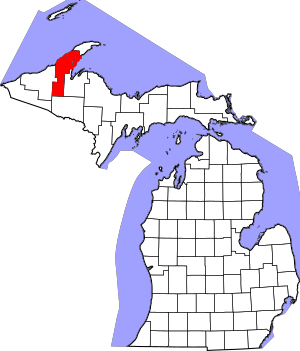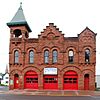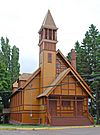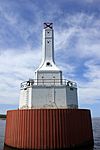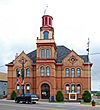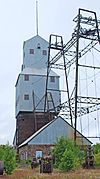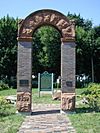National Register of Historic Places listings in Houghton County, Michigan
This article is a list of cool and important places in Houghton County, Michigan that are on the National Register of Historic Places. Think of the National Register as a special list of buildings, sites, and objects across the United States that are worth saving because of their history.
Houghton County has 42 places on this list, and two of them are even more special, called National Historic Landmarks! You can see where many of these places are on a map if their exact locations are listed.
A Look Back at Houghton County's History
How Houghton County Started
Houghton County was created in 1845. Back then, it was much bigger than it is today, including areas that are now Keweenaw County and Ontonagon County.
The Story of Copper Mining
The history of Houghton County is super connected to copper mining. Almost all the historic places on the National Register here are linked to these mines! The two most successful copper mines were the Calumet and Hecla Mining Company and the Quincy Mine. Both of these are now National Historic Landmarks.
Calumet and Hecla's Legacy
The Calumet Historic District is a National Historic Landmark that covers a big part of the town of Calumet, Michigan. It includes the Calumet and Hecla Industrial District, which has many of the old mining buildings, and the Calumet Downtown Historic District, which is the main shopping area. Calumet was largely a "company town," meaning the mining company built many of the buildings, like the Calumet Fire Station and Calumet Theatre. The Keweenaw National Historical Park is also mostly in Calumet.
Nearby, the town of Laurium was where many of the mine's bosses and office workers lived. The Thomas H. Hoatson House, built by a rich mining executive, is a great example.
The Quincy Mine Story
The other big mine in Houghton County was the Quincy Mine. This National Historic Landmark includes the mine property and nearby homes, plus the huge Quincy Mine No. 2 Shaft Hoist House. Another important Quincy property, the Quincy Mining Company Stamp Mills, is also on the National Register.
Just like Calumet, the town of Hancock was also a company town, but for the Quincy Mine. The fancy East Hancock area was home to mine workers and managers.
Other Important Mines
Other historic places are also connected to the copper mining industry. These include the Smith-Dengler House, built by the Wolverine Copper Mining Company. The Redridge Steel and Log Dams were built by two different mining companies working together. And the community of Painesdale, Michigan was built by the Champion Mining Company.
Town Life in Houghton County
Even though many communities were mining towns, they still needed shops, places to gather, and public services.
Busy Downtown Areas
The main shopping areas of four towns in Houghton County are on the National Register: the Calumet Downtown Historic District, the Lake Linden Historic District in Lake Linden, the Shelden Avenue Historic District in Houghton, and the Quincy Street Historic District in Hancock.
Some individual commercial buildings are also recognized for their history. These include the Joseph Bosch Building in Lake Linden, the J. Vivian, Jr. and Company Building in Laurium, and the Douglass House and Shelden-Dee Block (and the Ransom B. Shelden House) in Houghton.
Public and Government Buildings
Public buildings are another important group of structures. Mining companies often helped build these. Good examples are the Calumet Fire Station and the Hancock Town Hall and Fire Hall, both made of red sandstone. Other government buildings include the South Range Community Building, the Lake Linden Village Hall and Fire Station, and the Houghton County Courthouse.
Schools are also on the list, like the schools in Chassell and the College Club House and Gymnasium at Michigan Technological University.
Beautiful Churches
Some unique churches in the county include Saint Ignatius Loyola Church in Houghton, the First Congregational Church in Lake Linden, and the Jacobsville Finnish Lutheran Church.
Historic Places Across the County
| Name on the Register | Image | Date listed | Location | City or town | Description | |
|---|---|---|---|---|---|---|
| 1 | Big Traverse Bay Historic District |
(#75000946) |
East of Lake Linden at the mouth of the Traverse River 47°11′35″N 88°14′12″W / 47.193056°N 88.236667°W |
Lake Linden | This district is a Finnish fishing village at the mouth of the Traverse River. It has about 40 small, simple houses. | |
| 2 | Joseph Bosch Building |
(#82002839) |
302 Calumet Ave. 47°11′28″N 88°24′34″W / 47.191111°N 88.409444°W |
Lake Linden | The Joseph Bosch Building was built after a big fire in 1887. It was later turned into a candy shop and restaurant called the Lindell Chocolate Shoppe. Both the outside and inside are very well-preserved. | |
| 3 | Calumet and Hecla Industrial District |
(#74000985) |
Roughly bounded by the Hecla and Torch Lake Railroad tracks and Calumet Ave., Mine St., and Depot St. 47°14′33″N 88°27′00″W / 47.2425°N 88.45°W |
Calumet | This district has ten buildings from the Calumet and Hecla Mining Company's copper mines. It's part of the larger Calumet Historic District. | |
| 4 | Calumet Downtown Historic District |
(#74000986) |
5th and 6th Sts. between Scott and Pine Sts. 47°14′50″N 88°27′12″W / 47.247222°N 88.453333°W |
Calumet | This district has 62 buildings along Fifth and Sixth Streets, which is the main shopping area of Calumet. It's also part of the Calumet Historic District. | |
| 5 | Calumet Fire Station |
(#74000987) |
6th St. 47°14′52″N 88°27′13″W / 47.247778°N 88.453611°W |
Calumet | The Calumet Fire Station is a two-story building made of red sandstone. It was designed by Charles K. Shand and built in 1898–1899. Today, it's the Upper Peninsula Fire Fighters Memorial Museum. | |
| 6 | Calumet Historic District |
(#89001097) |
Area west of M-26 south of Calumet Lake to Osceola 47°12′55″N 88°27′02″W / 47.215278°N 88.450556°W |
Calumet | This district covers most of Calumet village and nearby areas. It's important because it shows how the Michigan copper industry worked, including mining, immigration, company towns, and labor groups. | |
| 7 | Calumet Theatre |
(#71000392) |
340 6th St. 47°14′55″N 88°27′12″W / 47.248611°N 88.453333°W |
Calumet | The Calumet Theatre, also known as the Calumet Opera House, is a two-story building made of yellowish-brown brick. It was designed by Charles K. Shand and is part of the Calumet municipal building. | |
| 8 | Chassell School Complex |
(#09000473) |
42373 and 42365 N. Hancock St. 47°01′37″N 88°31′38″W / 47.02687°N 88.52736°W |
Chassell | This complex has two old school buildings: Chassell High School and Southwell Elementary School. They were built in the 1910s and used as schools until the early 1990s. | |
| 9 | College Club House and Gymnasium |
(#80001861) |
1416 College Ave. 47°07′12″N 88°32′58″W / 47.12°N 88.549444°W |
Houghton | This building, also called the R.O.T.C. Building, is the oldest on the Michigan Technological University campus. Built in 1905–1906, it was used as a gym, for dances, and for graduation ceremonies. | |
| 10 | County Road C117 – Pike River Bridge |
(#99001517) |
County Road C117 (Old US-41) over the Pike River 47°01′07″N 88°31′36″W / 47.018611°N 88.526667°W |
Chassell | This bridge was one of the first main road bridges built using a special steel design. It's important because it's the only one of its kind from that time that is still standing and unchanged. | |
| 11 | Douglass House |
(#82002837) |
Sheldon Ave. and Isle Royale St. 47°07′19″N 88°34′01″W / 47.121944°N 88.566944°W |
Houghton | The original Douglass House was built in 1860. After it burned down in 1901, a new part of the current hotel was built in 1902. | |
| 12 | East Hancock Neighborhood Historic District |
(#80001859) |
Roughly bounded by Front, Dunston, and Vivian Sts. and Mason and Cooper Aves. 47°08′04″N 88°34′29″W / 47.134444°N 88.574722°W |
Hancock | This district has 88 homes, many built between 1890 and 1920 when Hancock was doing very well. They show different architectural styles like Queen Anne and Neo-Classical. | |
| 13 | First Congregational Church |
(#80001863) |
1st St. and M-26 47°11′19″N 88°24′39″W / 47.188611°N 88.410833°W |
Lake Linden | This church, built in the 1880s, is a great example of Victorian stick architecture. It was used until the 1980s and is now cared for by the Houghton County Historical Society. | |
| 14 | Hancock Town Hall and Fire Hall |
(#81000307) |
399 Quincy St. 47°07′37″N 88°35′06″W / 47.126944°N 88.585°W |
Hancock | Also known as the Hancock City Hall, this two-story building was built in 1899 from red sandstone. It shows influences from Richardsonian Romanesque and Dutch styles. | |
| 15 | Thomas H. Hoatson House |
(#94001426) |
320 Tamarack St. 47°14′08″N 88°26′29″W / 47.235556°N 88.441389°W |
Laurium | This house, now called the Laurium Manor Inn, was built in 1908 for Thomas Hoatson Jr., a very rich mining executive. | |
| 16 | Houghton County Courthouse |
(#75000945) |
401 E. Houghton St. 47°07′14″N 88°34′15″W / 47.120556°N 88.570833°W |
Houghton | The Houghton County Courthouse, built in 1886–1887, replaced an older building. It's a unique brick and sandstone building with a mansard roof, showing different architectural styles. | |
| 17 | Jacobsville Finnish Lutheran Church |
(#76001028) |
West of Jacobsville 46°59′04″N 88°25′07″W / 46.984444°N 88.418611°W |
Jacobsville | This one-story church was built in 1888 by Finnish settlers. It hasn't changed much since a bell tower was added in 1892. It's still used for services in the summer. | |
| 18 | Kaleva Temple |
(#82002840) |
Trimountain Ave. 47°04′12″N 88°38′34″W / 47.07°N 88.642778°W |
South Range | Local businessman Jacob Baer started building this commercial block in 1907. A Finnish society, the Kalevan Retaret, bought and finished it in 1910. It's a great example of local architecture. | |
| 19 | Keweenaw Waterway Lower Entrance Light |
(#14000426) |
S. end of breakwater at mouth of Portage R. 46°58′08″N 88°25′52″W / 46.9688°N 88.4311°W |
Torch Lake Township vicinity | This lighthouse marks the southeastern end of the Keweenaw Waterway. | |
| 20 | Keweenaw Waterway Upper Entrance Light |
(#14000425) |
E. breakwater Keweenaw Waterway, N. end, .4 mi. offshore 47°14′04″N 88°37′49″W / 47.2345°N 88.6302°W |
Hancock Township vicinity | Located near McLain State Park, this light marks the northwestern end of the Keweenaw Waterway. | |
| 21 | Keweenaw National Historical Park |
(#01000108) |
P.O. 471 47°09′23″N 88°33′49″W / 47.1564°N 88.5636°W |
Calumet | This park is part of the U.S. National Park Service. It has two main parts, the Calumet Unit and the Quincy Unit, plus 16 other "Heritage Sites" that tell the story of the Keweenaw Peninsula. | |
| 22 | Lake Linden Historic District |
(#09000522) |
Calumet St. between 1st and 8th plus parts of Hecla and Schoolcraft Sts. 47°11′33″N 88°24′32″W / 47.192572°N 88.408856°W |
Lake Linden | This district includes Lake Linden's main business area and nearby homes. Most buildings were built after a big fire in 1887 that destroyed much of the village. | |
| 23 | Lake Linden Village Hall and Fire Station |
(#81000308) |
401 Calumet Ave. 47°11′32″N 88°24′30″W / 47.192222°N 88.408333°W |
Lake Linden | This two-story building was built by L. F. Ursin and opened in 1902. It served as village offices, a fire station, and a meeting hall. | |
| 24 | Laurium Historic District |
(#04001578) |
Roughly bounded by Calumet, Stable, N. Florida, and Isle Royale Sts. 47°14′10″N 88°26′26″W / 47.236111°N 88.440556°W |
Laurium | This district covers almost all of Laurium village. It's mostly homes but also has commercial buildings. Most structures were built around 1900, during the peak of copper mining. | |
| 25 | Lieblein House |
(#80001860) |
525 Quincy St. 47°07′37″N 88°35′19″W / 47.126944°N 88.588611°W |
Hancock | The Lieblein House is a two-and-a-half-story Queen Anne-style house built in 1895. It's now used as an office building for Finlandia University and is called the Hoover Center. | |
| 26 | John J. Michels House |
(#91001018) |
1121 E. Houghton Ave. 47°07′10″N 88°33′26″W / 47.119444°N 88.557222°W |
Houghton | John J. Michels was a builder who constructed many large public and commercial buildings. He built this Queen Anne-style house for himself. | |
| 27 | Old Main, Suomi College |
(#72000618) |
Quincy St. on the Finlandia University campus 47°07′37″N 88°35′18″W / 47.126944°N 88.588333°W |
Hancock | In 1896, J. K. Nikander started Suomi College (now Finlandia University) to train ministers and teach English. Old Main was the first building, completed in 1900. | |
| 28 | Painesdale |
(#93000623) |
Area encompassing Painesdale streets and the Champion Mine 47°02′22″N 88°40′11″W / 47.039444°N 88.669722°W |
Painesdale | Painesdale was a mining town built by the Champion Mining Company between 1899 and 1917. It was a classic "company town" with many similar houses for workers. | |
| 29 | Quincy Mine No. 2 Shaft Hoist House |
(#70000271) |
Off US 41 47°08′15″N 88°34′25″W / 47.1375°N 88.573611°W |
Hancock | This building is part of the Quincy Mining Company Historic District. It holds the world's largest steam hoisting engine, which sits on the biggest reinforced concrete foundation ever poured. | |
| 30 | Quincy Mining Company Historic District |
(#89001095) |
Area north from Portage Lake to Quincy Hill and along US 41 47°08′18″N 88°34′11″W / 47.138333°N 88.569722°W |
Hancock | The Quincy Mine is a large group of copper mines near Hancock. It was known as "Old Reliable" because the company paid money to investors every year from 1868 to 1920. The mine operated from 1846 to 1945. | |
| 31 | Quincy Mining Company Stamp Mills Historic District |
(#07000750) |
M-26 near Torch Lake 47°08′48″N 88°27′36″W / 47.146667°N 88.46°W |
Osceola Township | This district has a historic stamp mill, which was used to crush copper-filled rocks. It was built by the Quincy Mining Company starting in 1888. The Great Depression caused the mine and mill to close in 1931. | |
| 32 | Quincy Street Historic District |
(#88000143) |
100, 200, and 300 blocks of Quincy St. and 416 Tezcuco St. 47°07′37″N 88°34′52″W / 47.126944°N 88.581111°W |
Hancock | This district covers the main business part of Hancock. Most buildings were built between 1880 and 1915. | |
| 33 | Redridge Steel and Log Dams |
(#92000166) |
North of County Road 557 at the Salmon Trout River 47°08′56″N 88°45′50″W / 47.148889°N 88.763889°W |
Stanton Township | In 1894, the Atlantic Mining Company built a timber dam here to supply water to its mill. When more water was needed, a steel dam was built in 1901. It's one of only three steel dams ever built in the United States. | |
| 34 | Saint Henry's Evangelical Lutheran Church and Cemetery |
(#13000665) |
M-38 (Laird Township) 46°45′53″N 88°47′03″W / 46.764722°N 88.784167°W |
Nisula vicinity | Saint Henry's Evangelical Lutheran Church was built in 1904 by Finnish settlers. The church closed in 1992 after its members joined other churches. | |
| 35 | Saint Ignatius Loyola Church |
(#87001261) |
703 E. Houghton Ave. 47°07′14″N 88°33′53″W / 47.120556°N 88.564722°W |
Houghton | Saint Ignatius Loyola Church is a Neo-Gothic Catholic church built between 1898 and 1902. It sits on a hillside overlooking downtown Houghton. | |
| 36 | Shelden Avenue Historic District |
(#87002154) |
Shelden, Lake, and Montezuma Aves. 47°07′21″N 88°34′04″W / 47.1225°N 88.567778°W |
Houghton | This district is a commercial area in Houghton with 43 important buildings. It includes shops, warehouses, and public buildings, showing many different architectural styles. | |
| 37 | Ransom B. Shelden House |
(#80001862) |
1304 College Ave. 47°07′15″N 88°33′13″W / 47.120833°N 88.553611°W |
Houghton | Ransom B. Shelden, Jr. built this Queen Anne house for his family in 1896. It's now used as the Tau Kappa Epsilon (TKE) Fraternity House. | |
| 38 | Shelden-Dee Block |
(#82002838) |
Shelden Ave. and Isle Royale St. 47°07′20″N 88°34′00″W / 47.122222°N 88.566667°W |
Houghton | In 1890, George C. Shelden bought this property. After he passed away, his wife and another businessman, James R. Dee, hired an architect to design this three-story Classical Revival commercial building. | |
| 39 | Smith-Dengler House |
(#08000221) |
58555 US 41 47°15′53″N 88°25′31″W / 47.264722°N 88.425278°W |
Calumet Township | The Wolverine Copper Mining Company built this house in 1899–1900 for Fred Smith, who managed the Wolverine and Mohawk Mines. Later, Theodore Dengler, the new superintendent, lived here. | |
| 40 | South Range Community Building |
(#81000310) |
Trimountain Ave. 47°04′11″N 88°38′36″W / 47.069722°N 88.643333°W |
South Range | This building was constructed in 1933-35 during the Great Depression to give jobs to local miners and craftsmen. It was meant to be a social and government center for South Range, and it still is today. | |
| 41 | J. Vivian, Jr. and Company Building |
(#03000625) |
342 Hecla St. 47°14′10″N 88°26′37″W / 47.236111°N 88.443611°W |
Laurium | The J. Vivian Jr. and Company building was first built in 1894 for a business. It was expanded in 1898 and 1906 as the business grew. |
Former Historic Places
| Name on the Register | Image | Date listed | Date removed | Location | City or town | Summary | |
|---|---|---|---|---|---|---|---|
| 1 | Italian Hall |
(#80001858) |
|
7th and Elm Sts. 47°14′54″N 88°27′19″W / 47.2484°N 88.4553°W |
Calumet | In 1913, copper miners in Calumet were on strike. On Christmas Eve, many families were at a party in the Italian Hall. Someone yelled "Fire!" and 73 people, mostly children, died trying to escape. The Hall was torn down in 1984, but a marker and some stones show where it used to be. |


